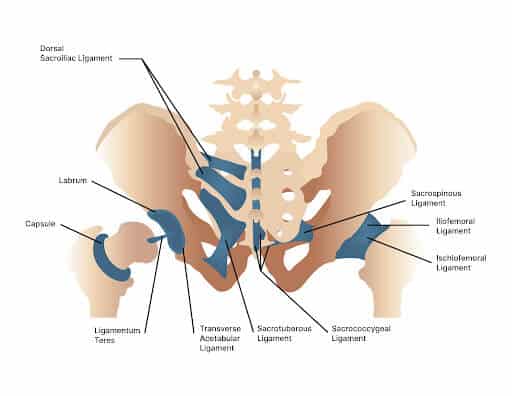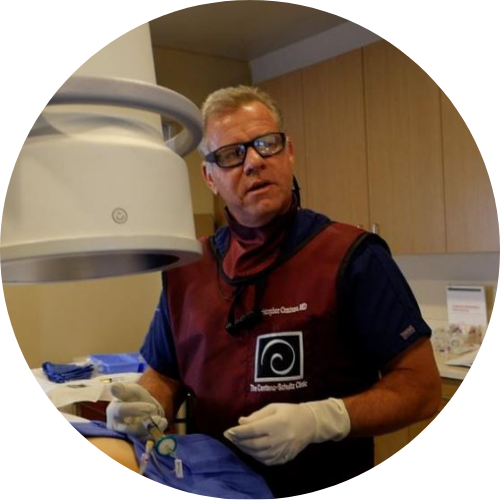Exploring Common Hip Ligament Injuries
Ligaments are connective tissue structures that connect bone to bone. They help provide stability for joints such as the hip. There are four main hip ligaments that help to keep the hip in its natural socket. If these ligaments are injured, then they may cause pain directly.
Most often, they cause the hip to become unstable, leading to more stress and injury to other parts of the hip such as the labrum, cartilage, and/or bone.
Different Ligaments in the Hip
The hip joint is a ball and socket joint formed by the femoral head (the ball at the top of the hip bone) and the acetabulum (the socket). It is surrounded by a thick articular capsule that is made up of four ligaments (the iliofemoral, ischiofemoral, pubofemoral ligaments, and ligamentum teres).
- Iliofemoral ligament: This ligament is in the front and on top of the hip capsule and is the strongest ligament in the body. It attaches to the femur and the anterior inferior iliac spine (AIIS). It is sometimes called the Y ligament of Bigelow due to its inverted Y shape. It supports standing posture and limits extension of the hip.
- Pubofemoral ligament: The pubofemoral ligament is in the front of the hip and is attached from the femur to the pubic bone. It is the weakest hip ligament, and it limits external rotation (rotating outward).
- Ischiofemoral ligament: The ischiofemoral ligament is in the back of the hip. It attaches to the back of the greater trochanter to the ischium. It prevents excessive hip flexion and internal rotation.
- Ligamentum teres: This ligament is deep within the hip joint. It is attached to the inner ball of the femur (called the fovea) and the deep inferior (lower) part of the acetabulum and another ligament called the transverse acetabular ligament.
The ligamentum teres is a secondary stabilizer that prevents the hip from coming out of the socket. There is a strong association of ligamentum teres injuries and labral tears.1

Causes of Injuries in the Hip Ligaments
In a hip hyperextension injury, the iliofemoral ligament can be injured. In excess external rotation, the pubofemoral ligament can be injured. In a hyperflexion injury, the ischiofemoral ligament can be injured. These injuries are generally caused in one of the following ways:
Trauma
Trauma such as a motor vehicle accident, fall, or direct blow to the hip can damage the ligaments.
Repetitive Microtrauma
This means repeated stress from activity being done with poor form, muscle and postural asymmetries, or excess force.
Latrogenic
This means a medical procedure caused an injury. The hip capsular ligaments can often be injured during a hip surgery such as arthroscopy, as a great amount of traction has to be applied to the hip joint in order to open it to allow access for the camera and surgical instruments.
Genetic Hypermobility or Connective Tissue Disorders
These are inherited issues that make all the body’s ligaments loose or weaker than a normal person’s ligaments. These are more prone to injury and arthritis due to excess movement in the joints.
Symptoms of Hip Ligament Injuries
The symptoms of hip ligament injuries include:
- Loud “pop” upon injury
- Bruising
- Inability to bear weight on the injured hip
- Poor or limited movement in the joint
- Pain with activity
- Pain with excess stretching of the joint
- Clicking sensation with movement
- Hip weakness
More Associated Symptoms
Butt Pain
Throwing this question out to the social-media masses is sure to bring out the cyber “comedians” among us, but the truth is when you really do have butt pain, it’s no laughing matter. So we’re glad you came here to ask because we actually do see many patients in our clinic with this problem. There are a number of issues that can cause butt pain, but the root causes we most often discover are hamstrings tendinopathy, a pinched low-back nerve, or sacroiliac joint syndrome. Let’s take a look at each of these individually. – Hamstrings Tendinopathy: The hamstrings are actually a collection of large muscles…
Read More About Butt PainFront of Hip Pain
Arthritis might be your first thought when you’re experiencing chronic pain at the front of your hip, but the truth is, there are many different issues that could be causing that hip pain. The ultimate goal, of course, is to fix the pain, but eliminating the pain once and for all involves also fixing the problem that is causing it…not just applying a temporary solution for pain relief. 5 Possible Causes for Front of Hip Pain Today we’re going to explore the hip and 5 possible causes for pain specifically in the front of the hip as well as cover ways you can test for each.
Read More About Front of Hip PainGluteus Medius Pain
The gluteus medius is one of the major muscles in your buttock and hip. There are three gluteal muscles you have probably heard about: They layer one upon the another much like a layer cake. The gluteus minimus is closest to the body followed by the gluteus medius and then the larger gluteus maximus.Gluteus Minimus – The gluteus minimus is the smallest of the three gluteal muscles. It is a small triangular muscle that lies underneath its bigger brother, the gluteus medius. It functions to stabilize the hip, rotate the thigh, and move the hip in an outward direction.Gluteus Medius -A powerful muscle that starts at the backside of your waist bone…
Read More About Gluteus Medius PainHip Pain
There are many causes of hip pain. Most individuals who experience hip pain believe that it comes from the hip. As a pain physician, I encounter a significant number of patients who have hip pain and who have been told they need either minimally invasive hip surgery, hip resurfacing surgery, or total hip surgery. Unfortunately that this is not always the case. The term referred to pain is one most of us know through TV or the movies. The most common is an individual who presents to the ER with severe arm or jaw pain. They don’t need to see a dentist or a surgeon…
Read More About Hip PainHip Pain that Radiates Down the Leg
Hip pain is miserable making walking across the room almost impossible at times. Hip labral tears are the most common cause, but there are more to consider. What is a hip labrum? Are there other causes of hip pain down the leg besides a hip labral tear? Does the presence of hip labral tear with pain down leg mean I need surgery? What are the treatment options for hip labrum tears? Given that labrum tears are present in patients without hip pain it is important to understand the other causes of anterior thigh and hip pain. SI Joint, muscles, irritation of low back nerves…
Read More About Hip Pain that Radiates Down the LegOuter Hip Pain
The hip is a ball-socket joint. The ball is the top part of the thigh bone (femur). The socket is formed by the ilium bone which is one of three bones that make up the pelvis. The ball-socket joint moves in different directions and is lined with cartilage. The actual hip joint is located approximately at the crease between your stomach and top of your thigh. This area is also known as the groin. The top of the ilium bone is called the iliac crest (waist bone). If you firmly place your hand on your waist you can feel a bone that spans your side.
Read More About Outer Hip PainDiagnosis of Hip Ligament Injuries
Diagnosis of hip ligament injuries can be difficult and these injuries are often missed or under diagnosed. The diagnosis requires referral to an orthopedic specialist such as a physical medicine and rehabilitation (PMR) doctor, sports medicine doctor, pain doctor or orthopedic surgeon.
The doctor will take a detailed history that would give clues to potential injury. They will then perform a detailed physical examination, testing the range of motion of the hip, looking for tender areas, performing specialized tests that stress the joint, labrum and ligaments, and they will also examine other associated body parts that may contribute to the problem.
Hip X-rays may be taken to look for bony deformities, fractures, arthritis, or signs of abnormal hip shape (dysplasia).
A hip MRI can show the soft tissues in better detail to reveal injuries to the bone, cartilage, labrum, ligamentum teres or signs of hip capsule injury, such as leakage of fluid from the joint.
Conventional Treatments
Typically, the first line of treatment for hip ligament injuries would be conservative. At home, patients can avoid aggravating activities, use heat or ice, or briefly take over-the-counter pain medications as needed. Conventional treatments may include:
Physical Therapy
After seeing a specialist and obtaining a diagnosis, physical therapy typically should be the first recommendation. Good physical therapy can help correct postural and biomechanical factors that may be leading to more stress on the hip.
It can help to mobilize the hip for improved range of motion and nutrient delivery, and it can help strengthen the muscle around the hip to provide more stability.
Steroid Injection
When physical therapy fails, a steroid injection is often recommended to help with pain. While this may help with pain in the hip joint, it does nothing to help to fix the damaged ligaments. In fact, steroids can actually cause damage to cartilage and ligaments and impair healing.2
Furthermore, if hip surgery were required in the future, steroids increase the risks of surgical complications and infection.3 For these reasons, most patients should avoid these injections.
Surgery
If physical therapy has failed after one to two months, patients would generally be left to deal with the dysfunction. The only other option would be surgery. Surgery for hip capsular ligament repair is newer and rare, so should only be performed in the most severe cases.
Ligamentum teres repair can also be done but again this is a difficult and invasive surgery with significant recovery times. Long-term results are unknown, as these surgeries are not well studied.
Regenerative Medicine for Injured Hip Ligaments
In lieu of invasive surgery, there are now novel regenerative medicine treatments that can help hip ligaments heal with much less invasive injections that help to facilitate healing.
At the Centeno-Schultz Clinic, we specialize in treating orthopedic problems such as hip ligament injuries with substances that help the body self-heal, called orthobiologics. Many of these orthobiologic techniques have been invented by doctors from the Centeno-Schultz Clinic.
Dr. Pitts invented a technique to accurately and safely inject the difficult to reach ligamentum teres. The image below shows this combined ultrasound and fluoroscopic (X-ray guided) injection from the textbook for which Dr. Pitts served as primary editor and author.
The two most common orthobiologics used for hip ligament tears are PRP and bone marrow concentrate containing stem cells.
- PRP (platelet rich plasma): This involves obtaining blood from a vein in a simple blood draw, centrifuging (spinning) that blood to separate the components, then isolating and concentrating the platelets.
At the Centeno Schultz Clinic, the healing agents from your own blood are concentrated and customized to each patient’s individual issue to promote your body’s natural ability to heal. PRP has growth factors that help stimulate soft tissue healing, similar to what happens when you heal from a cut on your skin.
PRP works well for mild hip ligament injuries.
- BMAC (bone marrow aspirate concentrate): BMAC contains stem cells and is obtained by taking bone marrow from the iliac crest (hip bone) in a safe and comfortable way. The bone marrow is processed similarly to PRP, to concentrate the cells in the marrow.
Those stem cells aid in healing as they contain stem cells, the most powerful healing cells. BMAC is used for more severe ligament tears.
In addition to using PRP or BMAC to help heal the hip ligaments, we also look for associated injuries with the hip cartilage, labrum, tendons, and bones that we can also treat and help heal.
Recovery from Hip Injuries is Possible
Don’t avoid the diagnosis of a hip ligament injury. Now there are safe and effective treatments that can help you stay active and avoid surgery.
At the Centeno-Schultz Clinic, we are specialists and pioneers of regenerative medicine. We offer patients the most advanced treatments for hip problems, including ligament tears. We can even treat the ligamentum teres that are often underdiagnosed and difficult to treat.
We want you to know there is help for you to recover from hip ligament and other orthopedic problems, so you can continue the activities you love without drugs or surgery.
There’s hope for even the most serious hip ligament injuries. Learn more about our alternatives to hip surgery.

Christopher J. Centeno, MD
Christopher J. Centeno, M.D. is an international expert and specialist in Interventional Orthopedics and the clinical use of bone marrow concentrate in orthopedics. He is board-certified in physical medicine and rehabilitation with a subspecialty of pain medicine through The American Board of Physical Medicine and Rehabilitation. Dr. Centeno is one of the few physicians in the world with extensive experience in the culture expansion of and clinical use of adult bone marrow concentrate to treat orthopedic injuries. His clinic incorporates a variety of revolutionary pain management techniques to bring its broad patient base relief and results. Dr. Centeno treats patients from all over the US who…
Read more
John Schultz, MD
John R. Schultz M.D. is a national expert and specialist in Interventional Orthopedics and the clinical use of bone marrow concentrate for orthopedic injuries. He is board certified in Anesthesiology and Pain Medicine and underwent fellowship training in both. Dr. Schultz has extensive experience with same day as well as culture expanded bone marrow concentrate and sees patients at the CSC Broomfield, Colorado Clinic, as well the Regenexx Clinic in Grand Cayman. Dr. Schultz emphasis is on the evaluation and treatment of thoracic and cervical disc, facet, nerve, and ligament injuries including the non-surgical treatment of Craniocervical instability (CCI). Dr. Schultz trained at George Washington School of…
Read more
John Pitts, M.D.
Dr. Pitts is originally from Chicago, IL but is a medical graduate of Vanderbilt School of Medicine in Nashville, TN. After Vanderbilt, he completed a residency in Physical Medicine and Rehabilitation (PM&R) at Emory University in Atlanta, GA. The focus of PM&R is the restoration of function and quality of life. In residency, he gained much experience in musculoskeletal medicine, rehabilitation, spine, and sports medicine along with some regenerative medicine. He also gained significant experience in fluoroscopically guided spinal procedures and peripheral injections. However, Dr. Pitts wanted to broaden his skills and treatment options beyond the current typical standards of care.
Read more
Jason Markle, D.O.
Post-residency, Dr. Markle was selected to the Interventional Orthopedic Fellowship program at the Centeno-Schultz Clinic. During his fellowship, he gained significant experience in the new field of Interventional Orthopedics and regenerative medicine, honing his skills in advanced injection techniques into the spine and joints treating patients with autologous, bone marrow concentrate and platelet solutions. Dr. Markle then accepted a full-time attending physician position at the Centeno-Schultz Clinic, where he both treats patients and trains Interventional Orthopedics fellows. Dr. Markle is an active member of the Interventional Orthopedic Foundation and serves as a course instructor, where he trains physicians from around the world.
Read more
Brandon T. Money, D.O., M.S.
Dr. Money is an Indiana native who now proudly calls Colorado home. He attended medical school at Kansas City University and then returned to Indiana to complete a Physical Medicine and Rehabilitation residency program at Indiana University, where he was trained on non-surgical methods to improve health and function as well as rehabilitative care following trauma, stroke, spinal cord injury, brain injury, etc. Dr. Money has been following the ideology behind Centeno-Schultz Clinic and Regenexx since he was in medical school, as he believed there had to be a better way to care for patients than the status quo. The human body has incredible healing capabilities…
Read moreOther Resources for Hip Ligament Injuries
-
What Is Golfer’s Knee, And What Can I Do About It?
The nature of golf is such that both the backswing and downswing affect the knee. The entire swing takes a little over one second. However, it can exert a force of 4 times the body weight on the front knee and 3 times the weight on the back knee (1). This makes knee injuries just as…
-
Understanding Anterior Longitudinal Ligament Injuries in Whiplash
The cervical anterior longitudinal ligament (ALL) is a very important neck ligament that can commonly be injured by whiplash. The head and neck snapping backward in whiplash cause injury to the ALL. It is important to understand how and why the ALL becomes injured in whiplash so the many consequences of that injury can be…
-
Spinal Anterior Longitudinal Ligament Function
Have you had a neck injury or whiplash trauma? Do you have neck pain, especially when looking up, and you don’t know the cause? Then you may want to learn about the cervical anterior longitudinal ligament (ALL). Anatomy of the Anterior Longitudinal Ligament The ALL is a strong, wide ligament that runs along the front…
-
Knee Pain Location Chart: What The Pain In Your Knee Means
The knee joint is the largest compound synovial joint of the human body. The joint has bones, cartilage, muscles, and bursae that are held together by ligaments and tendons. Damage to any of these structures can give rise to knee pain. The location of knee pain can be very telling, and can help narrow down…
-
Does a Torn Hamstring Require Surgery? Learn Your Best Alternative
Hamstring injuries range from mild strains to complete ruptures. The need for surgery often depends on the severity of the injury and the specific requirements of the individual, especially if the person is an athlete or has specific functional demands. Several factors influence the outcome of the surgery: Return to sport/activity: Many athletes can return…
-
Everything You Need to Know about Hip Ligaments
The hip joint is a large ball and socket joint that’s important for lower extremity movement. The joints consist of the articulation of the femur (upper thigh bone/ball) and the acetabulum (the socket). The bones are lined with cartilage and the acetabulum is lined with a fibrocartilage called the labrum. The hip joints, as with…
-
Neck X-Ray
The neck is a vital and complex part of the human anatomy, supporting the head and facilitating essential functions like movement, breathing, and communication. When neck pain, injuries, or other symptoms arise, healthcare providers often turn to diagnostic tools such as neck X-rays to assess the condition of the cervical spine and surrounding structures. Healthy…
-
Understanding the Role Of The Thoracic Spine Muscles
The thoracic spine plays a critical role in the stability and mobility of the upper body. Comprised of twelve vertebrae and an intricate network of muscles and ligaments, it serves as a central pillar supporting the structure and movement of the body. Understanding the role and function of thoracic spine muscles is pivotal for anyone…
-
Understanding Knee Pain Symptoms To Get The Best Treatments
Knee pain affects about 25% of the population (1). The knee joint involves three bones, namely the patella, the femur, and the tibia. Knee pain can be a sign of damage to the ligaments, bones, bursae, or muscle tendons because there are so many structures within the knee joint. In this post, we’ll discuss the…
References:
- Christopher M. Larson, Editorial Commentary: Ligamentum Teres Tears and Femoroacetabular Impingement: Complex Coexistence of Impingement and Instability, Arthroscopy: The Journal of Arthroscopic & Related Surgery, Volume 32, Issue 7, 2016, Pages 1298-1299,ISSN 0749-8063 https://doi.org/10.1016/j.arthro.2016.05.003.(https://www.sciencedirect.com/science/article/pii/S0749806316302286)
- McAlindon TE, LaValley MP, Harvey WF, et al. Effect of Intra-articular Triamcinolone vs Saline on Knee Cartilage Volume and Pain in Patients With Knee Osteoarthritis: A Randomized Clinical Trial. JAMA.2017;317(19):1967–1975. doi: 10.1001/jama.2017.5283), (Wang BL, Sun W, Shi ZC, et al. Decreased proliferation of mesenchymal stem cells in corticosteroid-induced osteonecrosis of femoral head. Orthopedics. 2008;31(5):444. doi:10.3928/01477447-20080501-33
- Ravi B, Escott BG, Wasserstein D, Croxford R, Hollands S, Paterson JM, Kreder HJ, Hawker GA. Intraarticular hip injection and early revision surgery following total hip arthroplasty: a retrospective cohort study. Arthritis Rheumatol. 2015 Jan;67(1):162-8. doi: 10.1002/art.38886